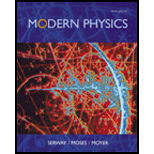
The magnitude of spin-orbit energy of an electron present in
Answer to Problem 15P
The magnitude of spin-orbit energy of an electron present in
Explanation of Solution
Consider an electron present in the
Write the expression for the magnetic moment of the electron.
Substitute
Substitute
Substitute
Here,
Write the expression for the energy.
Substitute
Substitute
Here,
The electron is present in the
Write the expression for magnetic field at the centre of current carrying loop.
Substitute
Here,
For a material, which is a simple one electron system, there exist only two possible energy states corresponding to
It means that the lower energy level which was initial aligned with the direction of magnetic field, angle between magnetic moment and magnetic field is
Therefore, the change in the energy is the sum of energy corresponding to each state.
Write the expression for the change in energy.
Here,
Conclusion:
Substitute 1 for
Substitute
Substitute 2 for
Thus, the magnitude of spin-orbit energy of an electron present in
Want to see more full solutions like this?
Chapter 9 Solutions
Modern Physics
- Assume that electrons in a 2- dimensional system has a linear dispersion relation: E = ~vFk, where vF is theFermi velocity. Obtain the density of states (DOS) for these electrons.arrow_forward) What are the allowed values for total spin angular momentum of the hydrogen atom having 1 proton and 1 electron, a deuterium atom and a tritium atom? Note: Your analysis should be restricted to just the spin angular momentum. The problem is not asking about orbital angular momentum. Based on your results, which atom types (hydrogen, deuterium, tritium) will respond as a composite boson?arrow_forwardFor a K*- CH ion pair, attractive and repulsive energies EA and ER, respectively, depend on the distance between the ions r, according to 5.8 x 10-6 1.436 EA and ER For these expressions, energies are expressed in electron volts per K*- CH pair, and r is the distance in nanometers. a) If the net energy EN is just the sum of the two expressions above: EN = E, + ER, Find the values of ro and E, ? b) If curves of E, ER, and EN are plotted in given figure, compare the calculated values of ro and E, with that from the graph. 2 am 0.00 010 0.20 0.30 040 0.70 00 1.00 Interatomic Separation, nm Bonding Energy, eVarrow_forward
- a) How many distinct angles from the vertical axis can the orbital angular momentum vector L make for an electron with l = 7? b)Calculate the smallest possible angle the L can make with respect to the vertical axis. (Hint: The smallest angle occurs when ml takes the maximum allowed value. Sketch L in that case and compare the vertical component, which is related to ml, to the magnitude of L, which is related to l.)arrow_forwardConsider a simple model of the helium atom in which two electrons, each with mass m, move around the nucleus (charge +2e) in the same circular orbit. Each electron has orbital angular momentum U (that is, the orbit is the smallest-radius Bohr orbit), and the two electrons are always on opposite sides of the nucleus. Ignore the effects of spin. What is the total kinetic energy of the electrons?arrow_forwardFind phonon density of states D(w) in 1D and 2D . Can phonon DOS be expressed as a function of energy? (I mean D(E)). I am asking this because I need to compare DOS of free electron and DOS of a phonon, and the DOS of a free electron is a function of energy D(E). If phonon DOS can be expressed as D(E) please find it in 1D and 2D.arrow_forward
- How many electrons can occupy the system with l=0, l=2 and l=4. What is number of possible orientations of the orbital angular momentum with l=4? What is the smallest z-component of the orbital angular momentum?arrow_forward13.10 If the radial momentum p, and radial velocity a, for an electron in a central potential are defined by r.p-ih a.r Pr = Xr= " r r show that ihk Ba, (ap) = ar Pr + r B(o'. L + h) where k = ħarrow_forwardCompute the intrinsic line-width (AX) of the Lyman a line (corresponding to the n = 2 to n = 1) transition for the Hydrogen atom. You may assume that the electron remains in the excited state for a time of the order of 10 s. The line-width may be computed using: e hc ΔΕarrow_forward
- Say that the surface of a star has a temperature of 6000 K and an electron density of n = 2.6 x 1019 electrons per m3. Using the Saha equation, what fraction of hydrogen atoms is ionized?arrow_forward.A neutral sodium atom has an ionization potential of 5.1 eV from its ground state.(1) What is the speed of a free electron that has just barely enough kinetic energy tocollisionally ionize a sodium atom in its ground state?(2) What is the speed of a free proton with just enough energy to collisionlly ionize thisatom?(3) What is the temperature of a gas in which the average electron kinetic energy is justbarely sufficient to ionize a sodium atom in its ground state?arrow_forward19.7 The variation principle can be used to formulate the wavefunctions of electrons in atoms as well as molecules. Suppose that the function Wma = N(a)e* with N(a) the normalization constant and a an adjustable parameter, is used as a trial wavefunction for the 1s orbital of the hydrogen t atom. Show that 3ah? 2a - 2e E(a)=- where e is the fundamental charge, and µ is the reduced mass for the atom. What is the minimum energy associated with this trial wavefunction?arrow_forward
 Modern PhysicsPhysicsISBN:9781111794378Author:Raymond A. Serway, Clement J. Moses, Curt A. MoyerPublisher:Cengage Learning
Modern PhysicsPhysicsISBN:9781111794378Author:Raymond A. Serway, Clement J. Moses, Curt A. MoyerPublisher:Cengage Learning University Physics Volume 3PhysicsISBN:9781938168185Author:William Moebs, Jeff SannyPublisher:OpenStax
University Physics Volume 3PhysicsISBN:9781938168185Author:William Moebs, Jeff SannyPublisher:OpenStax

